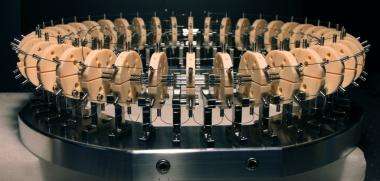October 29, 2010 feature
A milestone for molecular beams

(PhysOrg.com) -- When we think of molecular collisions, we often consider massive colliders, like the LHC, sending particles smashing into each other at very high energies. While this is interesting work, it’s not the only type of collision that requires study. "Normally, you have molecules colliding at high velocities," Gerard Meijer tells PhysOrg.com. "But we don’t know as much about low energy collisions. Being able to control molecules, and slow them down could provide another interesting line of study at the fundamental level."
Meijer is a scientist at the Fritz Haber Institute in Berlin, Germany. Working with a group of scientists from his institution, as well as from the Laser Centre at Vrije University in Amsterdam and the Institute for Molecules and Materials at Radboud University in Nijmegen, The Netherlands, Meijer demonstrated that it is possible to maintain control over neutral molecules traveling for a mile in a ring. Their work is published in Physical Review Letters: “Multiple Packets of Neutral Molecules Revolving for over a Mile.”
“Our experiment is really about getting complete control over molecules in beams,” Meijer explains. “We have shown that it is possible to completely control these packets of neutral molecules, and keep them in circle orbit – while at the same time making them move very slowly.”
The ring in question consists of 40 electrostatic focusing elements called hexapoles. The hexapoles keep a packet of molecules (for this experiment, ammonia) confined to a circular orbit. Even though we think of these types of machines as rather large, the setup in question is reasonably compact. “It fits almost on my table,” Meijer says. “The diameter is about 50 centimeters, making it possible to do the kinds of experiments we suggest with relative ease.”
The ring setup allows for the injection of 19 separate packets of molecules, all of them moving at the same pace, trailing each other by a fixed distance. Meijer and his colleagues were able to keep this up as the molecule packets made enough round trips through the ring to surpass the distance of a mile. “Interesting things happen when you can store molecules that long,” Meijer points out. “We’ve found that there are interesting things that happen with black body radiation, and this device could be one way to study these effects without the normally complicated experiments seen in the past.”
“Normally, your interaction time with a neutral molecule is quite small,” Meijer says, “only a millisecond. Our device allows you to extend the time to 10 seconds, providing the chance to study molecules much better. We can see how well we can control free molecules, and study them in more detail.”
So far, Meijer and the members of the team have not learned anything new. “We used a molecule we understand very well, since our goal was to demonstrate that it is possible to have this level of control over these molecules,” Meijer explains. It’s the next step, he says, that should be exciting.
“Right now, we have shown that we can control these molecules very well, with them all going the same direction,” Meijer says. “To study collisions, we are adding another beam that can inject molecules from the other side. Sometime next year, we should be able to set up for collision studies.”
“We have little information about what happens during collisions at low energies,” he continues. “Once we start the collisions with our machines, we should begin learning something new.”
More information: Peter C. Zieger, Sebastiaan Y.T. van de Meerakker, Cynthia E. Heiner, Hendrick L. Bethlem, André J.A. van Roij, and Gerard Meijer, “Multiple Packets of Neutral Molecules Revolving for over a Mile,” Physical Review Letters (2010). Available online: link.aps.org/doi/10.1103/PhysRevLett.105.173001
Copyright 2010 PhysOrg.com.
All rights reserved. This material may not be published, broadcast, rewritten or redistributed in whole or part without the express written permission of PhysOrg.com.

















